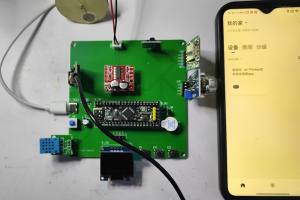设计说明书
总字数:21000+
摘要
随着教育事业的发展与家校出行需求的增加,校车作为学生往返学校的重要交通工具,其行驶安全直接关系到学生的生命健康,受到社会各界的高度关注。校车行驶过程中的超速、车内温湿度异常、有害气体超标等问题,若不能及时监测与干预,可能引发交通安全事故或影响学生身体健康,因此,研发一套能实时监测校车行驶状态、保障车内环境安全的智能系统具有重要现实意义。
本设计提出了一种基于 STM32F103C8T6 单片机的北斗校车安全驾驶系统。系统主要功能包括:通过 ATGM332D-5N GPS 模块获取车辆经纬度信息,实时定位校车行驶位置;借助 MX1508 驱动直流电机,配合 KY-003 霍尔传感器测量车辆行驶速度,当速度值超过设置最大值时,触发蜂鸣器报警提醒,同时支持两个按键手动调节速度阈值;通过 DHT11 传感器采集车内温湿度数据,实时监测车内环境舒适度;利用 MQ-135 传感器检测车内有害气体浓度,当气体值超出设置最大值时,蜂鸣器启动报警;用户可通过按键直接设置速度、有害气体浓度等各项监测阈值;系统通过 OLED 显示屏实时显示经纬度、速度、温湿度、有害气体值等测量数据;此外,通过 ESP8266-12F WIFI 模块可将所有监测数据传输至手机端,手机端也能远程设置各项阈值,实现多端协同监测与控制。
该校车安全驾驶系统的作用在于,为校车行驶安全与车内环境保障提供了一体化智能解决方案。通过实时定位、超速预警、环境监测及多端数据交互,能够帮助驾驶员及时规避安全风险,也方便学校与家长远程掌握校车动态,有效降低安全事故发生概率,保障学生出行安全与身体健康。
关键词:STM32F103C8T6 单片机;北斗校车安全;GPS 定位;速度监测;环境检测
Design of School Bus Safe Driving Based on Beidou
Abstract
With the development of education and the increasing demand for home school travel, school buses, as an important means of transportation for students to commute to and from school, have received high attention from all sectors of society due to their safety, which directly affects students’ lives and health. The problems of speeding, abnormal temperature and humidity inside the school bus, and excessive harmful gases during its operation, if not monitored and intervened in a timely manner, may lead to traffic safety accidents or affect students’ physical health. Therefore, developing an intelligent system that can monitor the real-time driving status of the school bus and ensure the safety of the in car environment is of great practical significance.
This design proposes a Beidou school bus safety driving system based on STM32F103C8T6 microcontroller. The main functions of the system include: obtaining vehicle latitude and longitude information through the ATGM332D-5N GPS module, and real-time positioning of the school bus’s driving position; Using MX1508 to drive the DC motor and KY-003 Hall sensor to measure the vehicle’s driving speed, when the speed value exceeds the set maximum value, the buzzer alarm reminder is triggered, and two buttons are supported to manually adjust the speed threshold; Collect temperature and humidity data inside the car through DHT11 sensors, and monitor the comfort level of the car environment in real time; Use MQ-135 sensors to detect the concentration of harmful gases inside the vehicle. When the gas value exceeds the set maximum value, the buzzer will activate an alarm; Users can directly set monitoring thresholds such as speed and harmful gas concentration through buttons; The system displays real-time measurement data such as latitude and longitude, speed, temperature and humidity, and harmful gas values through OLED display screens; In addition, all monitoring data can be transmitted to the mobile phone through the ESP8266-12F WIFI module, and the mobile phone can also remotely set various thresholds to achieve multi terminal collaborative monitoring and control.
The function of the school bus safety driving system is to provide an integrated intelligent solution for the safety of school bus operation and the protection of the in car environment. Through real-time positioning, overspeed warning, environmental monitoring, and multi terminal data exchange, it can help drivers avoid safety risks in a timely manner, and also facilitate remote monitoring of school bus dynamics by schools and parents, effectively reducing the probability of safety accidents and ensuring the safety and physical health of students’ travel.
Keywords:STM32F103C8T6 microcontroller; Beidou school bus safety; GPS positioning; Speed monitoring; Environmental Monitoring
目 录
1 绪论
1.1 研究背景及意义
1.2 国内外研究现状
1.3 主要内容
2 系统总体方案设计
2.1系统总体设计
2.2 主要模块方案选择
3 系统硬件设计
3.1 总体硬件框架
3.2 主控模块电路设计
3.3 GPS 定位模块电路设计
3.4 速度监测与电机驱动模块电路设计
3.5 环境检测模块电路设计
3.6 显示模块电路设计
3.7 按键模块电路设计
3.8 WIFI 通信模块电路设计
3.9 蜂鸣器报警模块电路设计
4 系统程序设计
4.1 编程软件介绍
4.2 主机系统主流程设计
4.3 独立按键
4.4 温湿度检测模块子流程
4.5 直流电机-MX1508驱动模块子流程
4.6 OLED显示流程设计
4.7 WiFi模块子流程设计
5 实物制作与功能测试
5.1 实物制作
5.2 GPS 定位功能测试
5.3 速度监测与报警功能测试
5.4 温湿度检测功能测试
5.5 有害气体检测与报警功能测试
5.6 WIFI 通信功能测试
5.7 按键阈值设置功能测试
5.8 OLED 显示功能测试
6 总结
参考文献
致谢
附录A 原理图
附录B PCB
附录C 主程序
购买后可查看具体内容!

